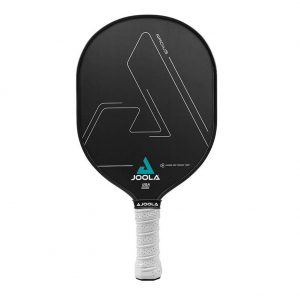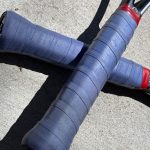Last time we talked about pickleball paddles, we talked about how the paddle surface affects your game. Here, we’ll discuss how the pickleball paddle shape makes a difference too. There are 2 hard and fast rules set by the USPA that regulate the size and dimensions of a paddle: the length plus width of a paddle cannot exceed 24 inches, and neither side can exceed 17 inches.
Standard Paddles
A standard-shaped paddle has dimensions somewhere in the ballpark of 8 inches wide by 16 inches long. Most paddles on the market don’t stray too far from these measurements. They offer a good balance of control and power, which makes them easy to recommend for players of all levels. When seeking out your ideal paddle, it may help to start with a paddle in the standard range and figure out what your wants and needs are. But it is also very likely that you’ll be perfectly satisfied with a standard-shaped paddle.

Wide Body Paddles
Wide-bodied paddles typically have widths around 8.5 inches while being about 15.5 inches long. These paddles are great for beginners because they offer more surface area compared to other paddle shapes. If we do some basic geometry, an 8.5″ by 15.5″ paddle has 131.75 square inches of surface area compared to an 8″ by 16″ paddle, which has a 128 square inch surface area. The main drawback of using a wide-body paddle is that they sacrifice a bit of reach. Many wide-bodied paddles compensate by lengthening the handle for more reach and the ability to use 2-handed strokes for more power. Players of all levels appreciate these paddles thanks to their ease of use, generous sweet spot, and maneuverability.

Elongated Paddles
An elongated paddle’s dimensions are about 7.5 inches wide and 16.5 inches long. In their most extreme forms, you can find paddles as long as 17 inches. These paddles can be difficult for beginners to get used to, as they have less hitting surface thanks to their narrower shape. However, the main advantages that elongated paddles offer are their extended reach and power. This shape also concentrates the sweet spot toward the upper end, allowing players to leverage even more power. If you’re consistent and confident in your shot, consider trying out an elongated paddle.

Square vs Curved Shaped
Most standard paddles have a square or rectangular shape to them. However, some paddles incorporate a curved edge. This curve can range from a gentle curve at the top or, on the extreme end, create a “teardrop” shape. This pickleball paddle shape sacrifices surface area to reduce drag, which in turn increases maneuverability. Similar to an elongated paddle, the rounded shape raises the sweet spot towards the top end of the paddle. This can add more power to wider paddle shapes or otherwise exaggerate the strengths of an elongated paddle even further.

Remember that there’s more to a pickleball paddle than just its shape. Materials, weight, and other factors all work in tandem to affect a paddle’s performance. For example, if you like using a wide-body paddle but want more power, you can look for a composite paddle to add more oomph to your shots without changing up your play style. Stay in touch with the Tennis Express blog for more info on pickleball and tennis!
For More:





